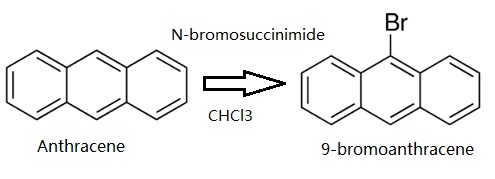| Identification | More | [Name]
9-Bromoanthracene | [CAS]
1564-64-3 | [Synonyms]
9-BROMOANTHRACENE
9-BROMOANTHRENE
MS-BROMOANTHRACENE
RARECHEM AQ BD AN02
TIMTEC-BB SBB007978
9-Anthracenyl bromide
Anthracene, 9-bromo-
9-Bromoanthracene98%
9-Bromoanthracene 98%
9-BROMOANTHRACENE: TECH., 90%
10-Bromoanthracene
9-Anthryl bromide
9-Bromo anthrecene | [EINECS(EC#)]
216-359-3 | [Molecular Formula]
C14H9Br | [MDL Number]
MFCD00001243 | [Molecular Weight]
257.13 | [MOL File]
1564-64-3.mol |
| Chemical Properties | Back Directory | [Appearance]
white to light yellow crystal powder | [Melting point ]
97-100 °C (lit.) | [Boiling point ]
303.85°C (rough estimate) | [density ]
1.4251 (rough estimate) | [refractive index ]
1.6404 (estimate) | [storage temp. ]
0-6°C
| [solubility ]
Chloroform (Slightly), DMSO (Slightly), Methanol (Slightly) | [form ]
Powder | [color ]
Yellow | [Water Solubility ]
Insoluble in water. | [BRN ]
1869747 | [InChI]
InChI=1S/C14H9Br/c15-14-12-7-3-1-5-10(12)9-11-6-2-4-8-13(11)14/h1-9H | [InChIKey]
ZIRVQSRSPDUEOJ-UHFFFAOYSA-N | [SMILES]
C1=C2C(C=C3C(=C2Br)C=CC=C3)=CC=C1 | [CAS DataBase Reference]
1564-64-3(CAS DataBase Reference) | [NIST Chemistry Reference]
9-Bromoanthracene(1564-64-3) |
| Safety Data | Back Directory | [Hazard Codes ]
Xi | [Safety Statements ]
S22:Do not breathe dust .
S24/25:Avoid contact with skin and eyes . | [WGK Germany ]
3
| [Hazard Note ]
Irritant | [HS Code ]
29039900 |
| Questions And Answer(Q&A) | Back Directory | [Description]
9-bromoanthracene(1564-64-3) is a kind of bromine-derived anthracene. It is known to be able to reversibly photodimerize in a head-to tail fashion upon irradiation by long-wavelength ultraviolet light. The photodimers of 9-bromoanthracene are suitable to be used as alkyl halide initiators in the atom transfer radical polymerization (ATRP) reactions. It is also used as the intermediate for the preparation of the 9-substitued form of the polycyclic aromatic hydrocarbon (PAH) anthracene.
| [Preparation]
Anthracene (5 g, 28.05 mmol) was dissolved in CHCl3. Then N-bromosuccinimide (NBS,4.99 g, 28.05 mmol) was added in batches away from light, and the reaction solution was continuously stirred for 12 h. The resulting mixture was stirred for another 30 min with appropriate water, and extracted with CH2Cl2. The CH2Cl2 solution was dried over anhydrous MgSO4. After removing CH2Cl2 solvent, the residue was recrystallized from anhydrous ethanol to give 4.78 g (66.3 %) of a green-yellow needle solid. 1H NMR (500 MHz, CDCl3) δ 8.55 (d, J = 8.9 Hz, 2H), 8.48 (s, 1H), 8.03 (d, J = 8.4 Hz, 2H), 7.67 – 7.60 (m, 2H), 7.56 – 7.51 (m, 2H). EI-MS (m/z): Calculated for C14H9Br: 257.13. Found [M+ ]: 255.96.

Synthesis of 9-bromoanthracene
| [References]
Cohen, Nicole A., et al. Macromolecular Chemistry and Physics 210.3 ‐4 (2009): 263-268.
Xu, Xiaoming, Wenzhe Lu, and Richard B. Cole. Analytical chemistry 68.23 (1996): 4244-4253.
Dang, Hung, and Miguel A. Garcia-Garibay. Journal of the American Chemical Society 123.2 (2001): 355-356.
|
| Hazard Information | Back Directory | [Chemical Properties]
white to light yellow crystal powder | [Uses]
9-Bromoanthracene(1564-64-3) acts as an intermediate in the preparation of 9-substituted derivative of the polycyclic aromatic hydrocarbon (PAH) anthracene.
| [Application]
The Sonogashira reaction of 9-Bromoanthracene(1564-64-3) and ethynyltrimethylsilane gave not only the expected anticipated 9-(trimethylsilylethynyl)anthracene and 2-(trimethylsilyl)aceanthrylene and (E)-4-(9-anthracenyl)-1,3-bis(trimethylsilyl)-but-3-en-1-yne were also obtained in moderate yields. The mechanistic principle may be that the coupling of bromo(anthracenyl)bis(triphenylphosphine)palladium(II) can occur either directly or after coordination and migratory insertion of the free alkyne.
| [Synthesis Reference(s)]
The Journal of Organic Chemistry, 57, p. 2740, 1992 DOI: 10.1021/jo00035a038 | [Properties and Applications]
9-Bromoanthracene(1564-64-3) could be used to synthesise 6-bromoaceanthrylene-1,2-dione by Friedel-Crafts acylation reaction with oxalyl chloride. The pure 9-Bromoanthracene’s energy level is -5.710 eV. A 1:1 co-crystal of Picric acid and 9-Bromoanthracene was prepared by a solvent evaporation method. The PIC: BRA co-crystal shows significantly reduced impact sensitivity relative to pure Picric acid. The primary non-covalent interaction occurs between the electron-poor π-system of Picric acid and the electron-rich π-system of 9-Bromoanthracene. The distance between the Picric acid centroid and the 9-Bromoanthracene centroid was measured to be 3.492 ?, a typical value in materials which exhibit aromatic face-to-face πinteractions (<4.00 ?). An interaction is also indicated between aromatic hydrogen on the 9-Bromoanthracene ring and nitro group oxygen on a parallel Picric acid ring (C3-H3…O6). The donor-acceptor π ... π interactions dominate the formation of the Picric Acid co-crystal. The π electron cloud of the 9-Bromoanthracene ring is concentrated towards the electron-poor region at the centre of the Picric acid moiety, and the two rings combine. The π system of picric acid is known to deform due to the electron-withdrawing effect of nitro groups and an electron vacancy formed at the centre of the ring. This is partially filled by π electrons of the 9-Bromoanthracene ring. In other words, a charge transformation complex is formed[4].
| [Purification Methods]
Crystallise 9-bromoanthracene from MeOH or EtOH followed by sublimation in vacuo. [Masnori et al. J Am Chem Soc 108 126 1986, Beilstein 5 IV 2295.] |
|
|